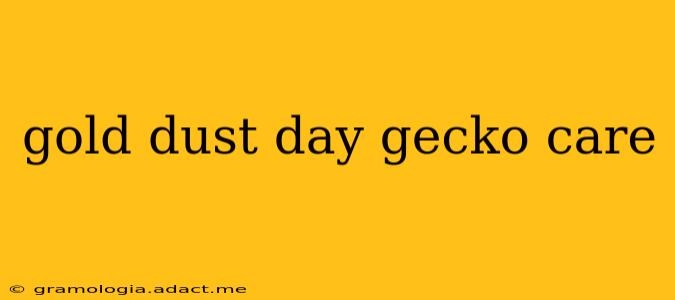The Gold Dust Day Gecko ( Phelsuma laticauda ) is a stunning reptile, captivating with its vibrant, speckled scales. These geckos, native to Madagascar and nearby islands, are becoming increasingly popular in the pet trade. However, providing proper gold dust day gecko care requires understanding their specific needs to ensure a long, healthy life. This comprehensive guide will delve into everything you need to know, addressing common questions and concerns.
What Do Gold Dust Day Geckos Eat?
Gold dust day geckos are insectivores. Their diet should consist primarily of insects, dusted with a high-quality calcium and vitamin D3 supplement. Suitable insects include crickets, mealworms, roaches (dubia roaches are a popular and safe choice), and fruit flies (especially for younger geckos). Variety is key! Avoid feeding wild-caught insects due to potential pesticide exposure and parasites. The size of the insects should be appropriate to the gecko's size – aim for insects no larger than the space between their eyes.
How Big Do Gold Dust Day Geckos Get?
Adult gold dust day geckos typically reach a length of 4-6 inches (10-15 cm), including their tail. Females tend to be slightly smaller than males. Their size makes them relatively manageable pets, but their vivarium needs to be appropriately sized to accommodate their activity levels.
How Long Do Gold Dust Day Geckos Live?
With proper care, gold dust day geckos can live for 8-10 years, sometimes even longer. Providing a suitable environment, a varied diet, and regular health checks are crucial to maximizing their lifespan.
Gold Dust Day Gecko Housing: Tank Setup and Size
The minimum recommended enclosure size for a single adult gold dust day gecko is a 18x18x24 inch (46x46x61 cm) terrarium. Larger is always better, especially if housing a pair. The enclosure should be tall to accommodate their climbing habits. Vertical space is more important than floor space.
Essential elements for the Gold Dust Day Gecko enclosure include:
- Substrate: Paper towels, reptile carpet, or a bioactive substrate (a mixture of soil, leaf litter, and other organic materials) are suitable choices. Avoid substrates that can be ingested and cause impaction.
- Branches and Vines: Provide plenty of branches and vines for climbing and basking. These should offer a variety of textures and thicknesses. Cork bark, wood pieces, and artificial plants can also be used.
- Hiding Places: Offer several hiding places, such as cork bark tubes, leaf litter, or artificial caves. This provides security and reduces stress.
- Basking Spot: Provide a basking spot with a temperature gradient. The basking spot should reach 88-92°F (31-33°C), while the cooler end of the enclosure should be around 75-80°F (24-27°C). A heat lamp or ceramic heat emitter can be used.
- UVB Lighting: Gold dust day geckos require UVB lighting to aid in calcium absorption and overall health. A quality UVB bulb should be used, and it should be replaced regularly according to the manufacturer's instructions. A timer should be used to simulate a natural day-night cycle (12 hours on, 12 hours off).
- Humidity: Maintain a humidity level of 60-80% through regular misting or the use of a fogger.
What is the best substrate for a Gold Dust Day Gecko?
As mentioned earlier, paper towels, reptile carpet, or a bioactive substrate are all suitable choices. The best choice will depend on your personal preference and experience level. Paper towels are the easiest to clean, while bioactive substrates provide a more natural and enriching environment.
How often should I mist my Gold Dust Day Gecko's enclosure?
The frequency of misting depends on the humidity levels in your enclosure. Aim for a humidity level of 60-80%. You may need to mist several times a day, especially in drier climates or with enclosures that lack good humidity retention. A hygrometer should be used to monitor humidity levels.
Gold Dust Day Gecko Breeding
Breeding gold dust day geckos requires experience and specialized knowledge. Successful breeding requires optimal conditions, including proper temperature, humidity, and a nutritious diet. It's essential to research thoroughly before attempting to breed these geckos.
Conclusion
Owning a Gold Dust Day Gecko can be incredibly rewarding. However, providing adequate care is crucial for their well-being. By following this guide and understanding their specific needs, you can help your gecko thrive and enjoy a long, healthy life. Remember to consult with a reptile veterinarian for any health concerns or questions.
